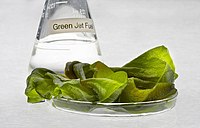
Photo from wikipedia
Microalgae can be incorporated in different bio-based products; however, the green colour is a barrier for a successful integration. This study aims to overcome this barrier by growing microalgae in… Click to show full abstract
Microalgae can be incorporated in different bio-based products; however, the green colour is a barrier for a successful integration. This study aims to overcome this barrier by growing microalgae in different cultivation modes. Mixotrophic cultivation of Chlorella protothecoides resulted in the highest biomass production after 5 days (5.56 ± 0.09 g/L), followed by heterotrophic and photoautotrophic cultivation (4.33 ± 0.15 and 1.80 ± 0.05 g/L, respectively). Mixotrophically and heterotrophically produced biomass presented a reduced greenish colouration compared to photoautotrophically produced biomass. Chlorophyll content resulted in 1.46 ± 0.21 and 0.95 ± 0.28 mg/g dry weight (DW) in mixotrophic and heterotrophic cultures, respectively, and 25.98 ± 1.28 mg/g DW in photoautotrophic cultures. In contrast, the fraction of carotenoids in the total pigments was much higher. With the whole microalgae fractions after cell disruption as ingredients, stable emulsions containing 50% oil could be produced. No syneresis with serum separation was observed 24 h after preparation.
Journal Title: Bioresource technology
Year Published: 2019
Link to full text (if available)
Share on Social Media: Sign Up to like & get
recommendations!